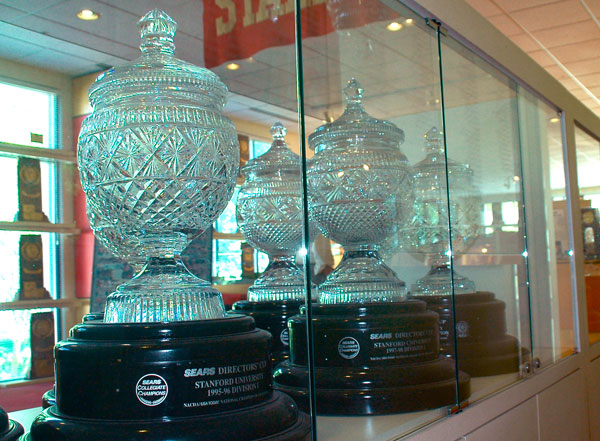Bulging with pride: Directors' Cup success tests limits of Stanford's Hall of Fame room
The good news is that Stanford recently won its 18th straight Directors' Cup, which recognizes the best collegiate sports program in the nation. The bad news is that there isn't any place to put the new 2-foot-tall, solid-crystal trophy. But it's a nice problem to have.
Unlike last year's fashion trends, the Learfield Sports Directors' Cup never gets old.
The award is given annually to the nation's most successful collegiate athletic program. In the 19 years of the contest, Stanford has won 18 times.
Patrick Dunkley, interim director of athletics, picked up the 2012 Directors' Cup on June 26 at the National Association of Collegiate Directors of Athletics meeting in Texas.
The trophy consists of a crystal cup with a solid base. It weighs about 30 pounds, stands more than 2 feet tall and was clearly made to be displayed.
Just ask Richard Dundas, a Stanford graduate and five-year docent at the Sydney and Theodore Rosenberg Hall of Fame. Dundas helps oversee the Hall of Fame – located in the Arrillaga Family Sports Center – and the 14 Directors' Cups displayed there. The other four are located upstairs in the athletic administrative offices because Stanford simply ran out of room in the Hall of Fame.
"It's the most significant display and represents the university's overall athletic success and fame. Most visitors are in awe when they see it," said Dundas, who readily admits that the display is his favorite part of the Hall of Fame room, too.
But there is a slight problem. When your Hall of Fame room is only 4,000 square feet, what do you do with 540 collective pounds of crystal?
Sheer dominance
Walk into the Hall of Fame room, and the first thing you will see is the immense glass case filled to the brink with Directors' Cup trophies.
"As you walk in, the sheer dominance and presence of so many Directors' Cups that are all just jammed in the case and you are, like, oh my gosh!" said Earl Koberlein, senior associate director for intercollegiate sports. "It shows we are a broad-based program. We are not just a football or basketball power. It represents all of our teams and the success they have, and we are very proud of that result."
But Koberlein acknowledged, "It's a running joke we talk about: Where are we going to put them all?"
The Hall of Fame opened in January 1994, coincidentally the first year the Directors' Cup was awarded – and the only year Stanford didn't win. North Carolina placed first and Stanford second. Since that year, Stanford hasn't lost, despite tweaks in the scoring rules that were designed to increase competition.
The room was envisioned by former athletic director Ted Leland as a place to display the university's many athletic awards, which at that time were scattered throughout the university.
"We had no place to store memorabilia and trophies, or do media interviews – no place for the general public," said Leland, who is now at the University of the Pacific.
From the start, Leland suspected the room would be too small to showcase all the university's athletic accomplishments. But he hoped video displays would help communicate accomplishments without taking up much room. Still, according to Ray Purpur, deputy director of athletics, the Stanford Hall of Fame room is the smallest among all Pac-12 universities.
Purpur, who oversees facility development and management, is looking for ways to adequately display Stanford's athletic heritage by converting other, unused space in athletic facilities.
"We don't have any plans to rebuild the entire room," he said. "We are more looking toward the concept of distributing our memorabilia and history around to other parts of the facilities."
The room attracts about 6,500 visitors a year. Understood in context, that's a thousand fewer people than attend an average men's basketball game and a little more than 10 percent of a sold-out home football game.
Along with the 14 Directors' Cups, the room has much to offer. Among the featured items are football legend Jim Plunkett's Heisman trophy, swimmer Mike Bruner's 1976 Olympic gold medal and old game tickets, posters and programs from more than 100 years of Big Games.
A new challenge
In addition to winning the 2012 Directors' Cup, Stanford also earned its second consecutive Capital One Cup for women's athletics in mid-June. That trophy recognizes the nation's best men's and best women's Division 1 athletic programs. Capital One annually awards a combined $400,000 in student-athlete scholarships and the Capital One Cup trophy to the winning schools during the ESPY Awards, which will air on ESPN today (July 11).
Koberlein said he and others in Stanford athletics don't feel pressure to keep winning awards. The goal of the athletic program, instead, is to provide a great experience for student athletes and allow them to succeed both academically and athletically.
"And, with that, we would hope teams win national championships. As that happens, we would be fortunate enough to win the Directors' and Capital One Cups," Koberlein said.
Still, it's probably a good thing the Capital One Cup is a significantly smaller trophy.
Kaitlyn Lo is an intern with Stanford University Communications.


Share This Story